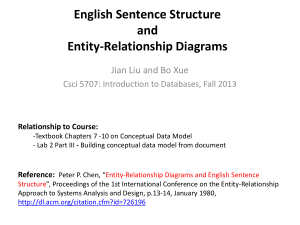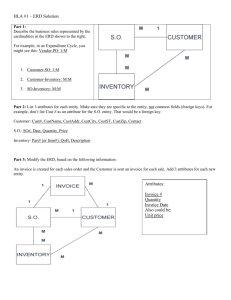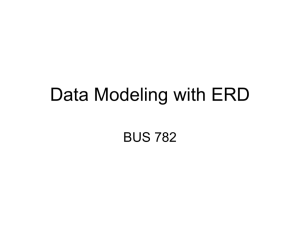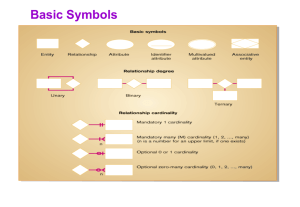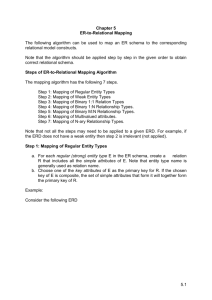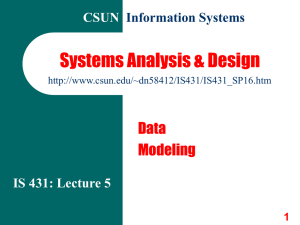Exam 2 Answers
advertisement
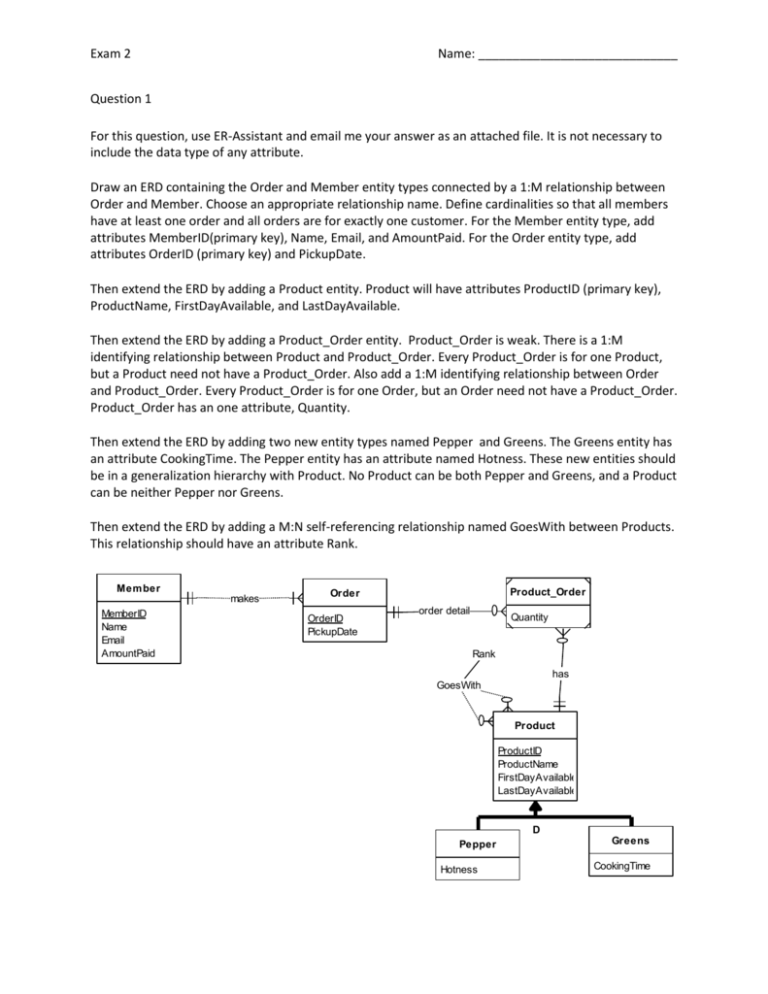
Exam 2 Name: _____________________________ Question 1 For this question, use ER-Assistant and email me your answer as an attached file. It is not necessary to include the data type of any attribute. Draw an ERD containing the Order and Member entity types connected by a 1:M relationship between Order and Member. Choose an appropriate relationship name. Define cardinalities so that all members have at least one order and all orders are for exactly one customer. For the Member entity type, add attributes MemberID(primary key), Name, Email, and AmountPaid. For the Order entity type, add attributes OrderID (primary key) and PickupDate. Then extend the ERD by adding a Product entity. Product will have attributes ProductID (primary key), ProductName, FirstDayAvailable, and LastDayAvailable. Then extend the ERD by adding a Product_Order entity. Product_Order is weak. There is a 1:M identifying relationship between Product and Product_Order. Every Product_Order is for one Product, but a Product need not have a Product_Order. Also add a 1:M identifying relationship between Order and Product_Order. Every Product_Order is for one Order, but an Order need not have a Product_Order. Product_Order has an one attribute, Quantity. Then extend the ERD by adding two new entity types named Pepper and Greens. The Greens entity has an attribute CookingTime. The Pepper entity has an attribute named Hotness. These new entities should be in a generalization hierarchy with Product. No Product can be both Pepper and Greens, and a Product can be neither Pepper nor Greens. Then extend the ERD by adding a M:N self-referencing relationship named GoesWith between Products. This relationship should have an attribute Rank. Mem ber makes MemberID Name Email AmountPaid Product_Order Order OrderID PickupDate order detail Quantity Rank has GoesWith Product ProductID ProductName FirstDayAvailable LastDayAvailable D Pepper Hotness Greens CookingTime Question 2 For this question, use ER-Assistant to create an E-R diagram for the following narrative. Email me your answer as an attached file. It is not necessary to include the data type of any attribute. You are writing a database for a newspaper delivery business. You keep track of the email, name, home phone, address, city, state, and zipcode of your customers. You keep track of all the newspapers you deliver. You keep track of the name and price of each newspaper. A customer could get many newspapers, and a newspaper could be delivered to many customers. All customers must have ordered at least one newspaper, but a newspaper may not have been ordered by anyone. Some of your customers have referred other customers to you. You keep track of everyone that each customer has referred to you. Assume that each customer could have referred many customers, but each customer could be referred by at most one other customer. Customers sometimes contact you. For each contact, we keep track of the date and time of the contact. Each contact is either a complaint or a request to suspend delivery. You keep track of the reason for the complaint. You keep track of the SuspendDate and the ResumeDate. You keep track of all tips that your customers give you. A customer could give you many tips, but each tip is from one customer. You keep track of the date and the amount of each tip. referred Custom er CustomerID email name homephone address city state zipcode New spaper New spaperID npname npprice ordered Contact customerGives makes contactID contactdate contacttime Tips tipID tipdate tipamount com plaint reason D,C suspenddelivery SuspendDate ResumeDate Question 3 Convert the following E-R diagram into a set of tables. Write your answer on the test paper. You don’t have to write the SQL command – just use a parenthesized list for each table and underline the primary key. Date Prison IsIn PrisonerID Name DOB D,C For Report DeathRow Cells Medium Security SolitaryCells Text Prisoner PrisonID Name Gender City MaxSecurity RatsOn MinSecurity ReportDate ReportText WorkRelease Prison(PrisonID, Name, Gender, City) MaxSecurity(PrisonID, DeathRowCells) MediumSecurity(PrisonID, SolitaryCells) MinSecurity(PrisonID, WorkRelease) Prisoner(PrisonerID, Name, DOB, PrisonID) Report(PrisonerID, ReportDate, ReportText) ParoleOfficer(OfficerID, Name, DateHired) MeetsWith(PrisonerID, OfficerID, Notes, MeetingDate) RatsOn(PrisonerID, OtherPrisonerID, Date, Text) ParoleOfficer MeetsWith Notes OfficerID Name DateHired MeetingDate Question 4 Assume that you have the following table: (A, B, C, D, E, F, G, H, J, K, L) Assume that the following functional dependencies are valid: A → E, F, G, H B → J, K, L F → G, H G→H Convert the table into 3NF. Write your answer on the test paper. Is already 1NF. Convert to 2NF (A, E, F, G, H) (B, J, K, L) (A, B, C, D) Convert to 3NF (A, E, F) (F, G) (G, H) (B, J, K, L) (A, B, C, D)
